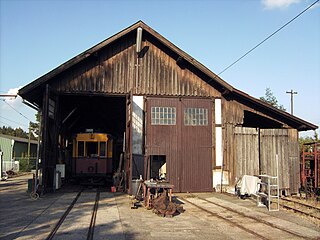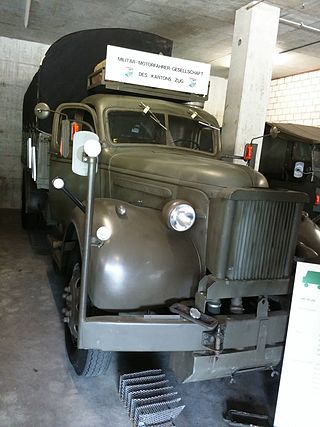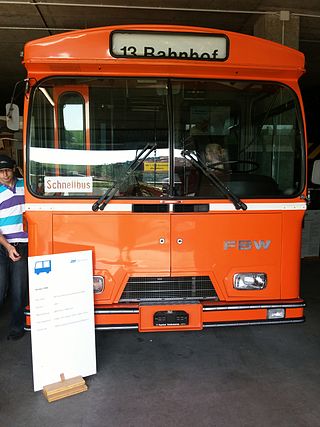
The Stuttgart Rack Railway is an electric rack railway in Stuttgart, Germany. It is the only urban rack railway in Germany, and one of only four rack railways operating in Germany, along with the Bavarian Zugspitze Railway, the Drachenfels Railway and the Wendelstein Railway.

Franz Brozincevic & Cie (FBW) was a Swiss maker of trucks, motorbuses and trolleybuses, founded by Croatian-born engineer and constructor Franjo (Franz) Brozinčević (1874-1933), active between 1922 and 1985 and based in Wetzikon, canton of Zürich.

The Florianerbahn is a museum tramway in Upper Austria that is not operational due to construction work. It was built as a railway - a licensed narrow gauge Lokalbahn or branch line - between the independent commununity of Ebelsberg and Sankt Florian. It was owned by the Lokalbahn Ebelsberg–St. Florian AG, but operated by the firm of Stern & Hafferl from Gmunden. Because the line had the character of a tramway (Überlandstraßenbahn) it switched over to providing tramway services in the wake of the annexation of Austria in 1938 – along with Stern & Hafferl's sister companies Elektrische Lokalbahn Unterach–See and Elektrische Lokalbahn Gmunden.

The Rhaetian Railway Ge 6/6 II is a class of heavy metre gauge electric locomotives operated by the Rhaetian Railway (RhB), which is the main railway network in the Canton of Graubünden, Switzerland.

The Rhaetian Railway Ge 4/6 was an eight member class of metre gauge 1′D1′ electric locomotives formerly operated by the Rhaetian Railway (RhB), which is the main railway network in the Canton of Graubünden, Switzerland.

The Orion Autobus is a bus from the Swiss manufacturer "Automobile Factory Orion" from Zurich.

The Geser F-250 4x4 is a fire-fighting vehicle from Switzerland.

The Mowag W300 is a fire-fighting vehicle from Switzerland. It is a rebadged variant of the Dodge W-Series trucks.

The GMC AC 454 is a truck model that the GMC manufactured from 1940 on.

ESZ Personenwagen C 36 – C 38 was the name of three two-axle passenger cars of the electric trams in the canton of Zug (ESZ).

The APE 4.80 is a passenger trailer wagon and was built by the Swiss manufacturer Gebrüder Moser + Cie and Ramseier & Jenzer + Cie, both in Bern, for the Zugerland Verkehrsbetriebe (ZVB).

The FBW 91U EU4A is a bus of the Swiss manufacturer Franz Brozincevic Wetzikon (FBW), from Wetzikon.

The Saurer 5 DUK is a bus of the Swiss manufacturer Adolph Saurer AG, from Arbon.
The Militärhistorische Stiftung des Kantons Zug MHSZ is a foundation consisting of a group of Military Museums in the canton of Zug with the purpose of safeguarding and cultivating the military heritage of the Swiss Confederation in the canton of Zug.

The Huttwil–Wolhusen railway line is a single-track standard-gauge railway line in Switzerland and currently operated by BLS AG. It was built by the Huttwil-Wolhusen-Bahn (HWB), based in Willisau, and opened on 9 May 1895. Operations were managed by the Langenthal-Huttwil-Bahn (LHB), which owned and operated the Langenthal–Huttwil railway. On 1 January 1944, the HWB was merged into the Vereinigte Huttwil-Bahnen, which was later merged into BLS AG.

The Oberaargau-Jura Railways was a former railway company in Switzerland. It was created in 1958 from the merger of the Langenthal-Jura Railway with the Langenthal–Melchnau-Bahn. The name refers to the Oberaargau and the Swiss Jura. The OJB changed its name to Regionalverkehr Oberaargau on 2 July 1990.

The Langenthal-Jura Railway was a former railway company in Switzerland. It merged in 1958 with the Langenthal–Melchnau-Bahn to form Oberaargau-Jura Railways, which then operated the then still 11 km-long, metre-gauge LJB line from Langenthal to Niederbipp. After further mergers, the Langenthal–Oensingen railway line has been part of the Aare Seeland mobil (ASm) since 1999.

The Solothurn–Niederbipp railway line is a 1,000 mm railway line in the cantons Bern and Solothurn, Switzerland. It runs 14.5 kilometres (9.0 mi) from Solothurn to Niederbipp. The line was built in 1918 by the Solothurn-Niederbipp-Bahn and is now owned and operated by Aare Seeland mobil (asm).
The Aare Seeland mobil AG based in Langenthal is a transport company in Switzerland. It was created in 1999 from the merger of Oberaargau Regional Transport, the Solothurn-Niederbipp Railway, the Biel-Täuffelen-Ins Railway and the Oberaargauische Automobilkurse.























